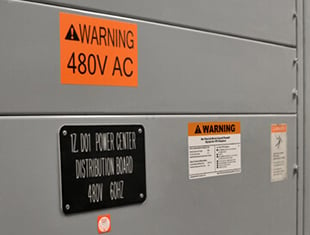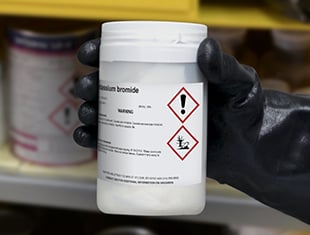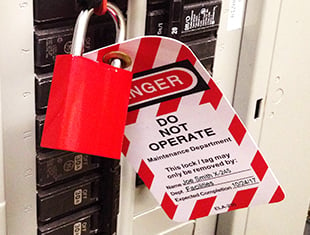GHS & HazCom for Chemical Safety
Webinar | GHS & HazCom for Chemical Safety
GHS & HazCom for Chemical Safety
Maximize facility safety with two chemical safety approaches
- Get the background and purpose of GHS and HazCom systems
- Understand each part of an OSHA-compliant chemical label
- Get steps to implement HazCom in your facility
 30 MINS
30 MINS Presented By

Brian McFadden
Technical Writer
Compliance Specialist
Related Resources
Transcript
Webinar Preview
Contents of the GHS & HazCom for Chemical Safety Webinar:
- Hazard Classification: Heart of the System
- Health, Physical, and Environmental Hazards
- The SDS: Detailed Information
- Sixteen Sections
- SDS Availability
- Authoring an SDS
- Container Labels: Immediate Advice
- Standardized GHS-style Labels
- Simplified Labels for In-Facility Use
- Training: the Human Element
- Implementing GHS/HazCom in Your Workplace
- Write It Down
- Label Your Containers
- Train, Evaluate, and Improve
An excerpt from the GHS & HazCom for Chemical Safety Webinar transcript:
Standardized GHS-style Labels
Every container of a hazardous material needs a label of some kind. The labeling scheme described in the GHS standard uses six building blocks, and all six are included in OSHA's preferred labels under HazCom 2012.
The six building blocks for these labels are:
- product identifier,
- signal word,
- hazard pictograms,
- hazard statements,
- precautionary statements,
- and supplier information.
Product Identifier
First is the Product Identifier, which identifies the product - basically, it's the name of the chemical. It needs to be specific, and match the name given on the material's SDS. If we're looking at a mixture of chemicals, the Product Identifier section needs to include any ingredients that contribute to the mixture's health hazards.
Additional details like a UN number, CAS number, or EC number may also be listed here. These numbers specifically identify chemicals as they appear in standardized listings. Not all chemicals have these numbers, and they're not required, but if a number has been assigned to the chemical in question, including it on the label can offer an additional degree of certainty.
Signal Word
Next, the Signal Word quickly indicates the overall severity of the chemical's hazards:
- "Danger" is used for the most severe hazards,
- "Warning" is used for less extreme hazards,
- and if the threats are relatively minor, no signal word may be required.
Each hazard class and category is associated with one of these three choices for signal words.
If a given material poses more than one hazard that would require the "Warning" signal word, you may choose to use the "Danger" signal word instead, reflecting the total, overall severity.
Hazard Pictograms
The most recognizable parts of a HazCom 2012 or GHS label are the Hazard Pictograms. These eye-catching symbols appear in black inside a red diamond outline, and they quickly convey the general type of hazard that a chemical poses. There are only nine of these symbols:
- Exclamation (or General Alert),
- Health Hazard,
- Skull and Crossbones,
- Flame,
- Oxidizer (or Flame over Circle),
- Explosive,
- Corrosive,
- Gas Cylinder (or Compressed Gas),
- and Environmental Hazard.
Under OSHA's rules in HazCom 2012, the Environmental Hazard pictogram is not required. Most facilities still choose to include it, because it's part of the overall GHS approach, and is required in many other countries.
Hazard Statements
Next, the Hazard Statements give a simple and consistent identification for each hazard posed by the material. These are phrases like "highly flammable gas," or "harmful if swallowed," which directly tell a reader what the hazard is. The exact wording for each Hazard Statement is set in the regulations, and each statement that applies to a chemical needs to appear on the SDS and on the container label.
Precautionary Statements
The Precautionary Statements describe recommended steps to prevent or minimize the adverse effects of exposure to the material. Because the appropriate steps may vary, based on things like the size of the container, and the application of the chemical, these steps may be edited somewhat for the label. While hazard statements need to appear exactly the way they do in the regulations, precautionary statements can be combined or reformatted as long as the relevant information is still effectively provided.
Supplier Information
Finally, the Supplier Information gives the name, address, and telephone number of the material's supplier. If an emergency contact number is available, it should be included here as well. This section provides traceability, as well as a way to request more information, if needed.
Simplified Labels for In-Facility Use
The fully-detailed GHS-style labels form a very effective way to inform workers about a material. But where a given container won't leave its facility, it's possible for an employer to provide adequate protection for their workers with a simpler label system. OSHA has a relaxed set of requirements for these "workplace" container labels.
You're still allowed to use the full GHS-style labels, of course, but other label styles are allowed, as long as they meet these three criteria:
- Workplace labels must show the product identifier, so there's no confusion about the contents of the container. The product identifier still has to match the name that appears on the material's SDS.
- Workplace labels must give at least basic hazard information for the chemical, although this information can be provided with symbols, text, or a combination of elements. The flame pictogram, or the word "flammable," may be enough to satisfy this requirement, if that's the only hazard posed by the material.
- Finally, workplace labels, combined with other information immediately available to workers in the area, must provide complete and detailed information about the hazards of the material. This requirement can be met with a copy of the SDS, as long as it's immediately available - that's the key.
The full GHS-style labels meet all three of these points, but many other approaches can work, too. However, many facilities find that having a single, consistent approach for all chemical labels makes it easier to train workers and maintain safe practices. You'll need to choose an approach that works for your facility.
To learn key elements of the GHS and HazCom 2012 approaches to chemical safety, where they came from, and how to implement these systems, watch the full webinar on demand now!
Related Resources

Labeling for Arc Flash Hazards
Presented By Brian McFadden Technical Writer Compliance Specialist Related Resources Arc Flash Labels Arc ...
Watch Now
Chemical Risk Assessments
Presented By Brian McFadden Technical Writer Compliance Specialist Related Resources Risk Management ...
Watch Now
Electrical Safety with Lockout/Tagout
Presented By Brian McFadden Technical Writer Compliance Specialist Related Resources Sample LO/TO Sequence ...
Watch Now.png)





